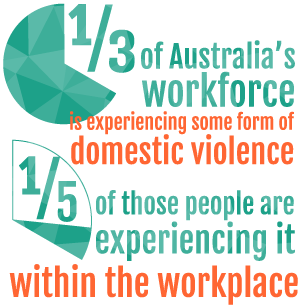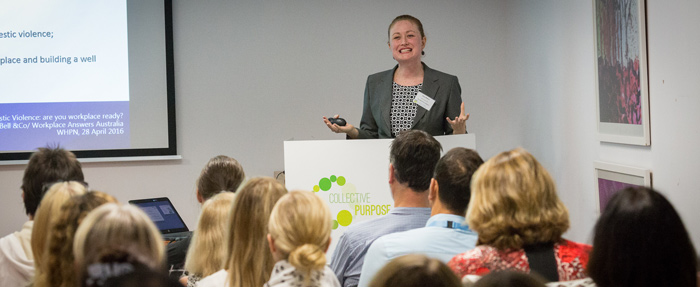Domestic Violence and the Workplace
At the WayAhead hosted quarterly network meeting of WayAhead Workplaces our workplace health network in 2016, there were talks from various speakers on topics such as “Improving People’s Ability to Plan for a Secure Financial Future.” And “Learnings in Engagement”. But perhaps most importantly it featured a talk about Domestic Violence and its effects and implications in the workplace.
Abby Millerd an employment lawyer and senior associate at Terri Bell & Co. gave a presentation on the issue of Domestic Violence in Australian workplaces and how we need to learn to deal with this issue.
 Often seen as an issue that exists purely within the private sphere of home and family life Domestic Violence is becoming a topic that has become more prominent in the public discourse over the past few years, partially thanks to the work of individuals such as Rosie Batty, and the various organisations and institutions which supported her. In terms of pure statistics Ms. Millerd estimated that approximately a third of Australia’s workforce is experiencing some form of domestic violence in their lives, and that one fifth of those people are experiencing it within the workplace – an alarming statistic.
Often seen as an issue that exists purely within the private sphere of home and family life Domestic Violence is becoming a topic that has become more prominent in the public discourse over the past few years, partially thanks to the work of individuals such as Rosie Batty, and the various organisations and institutions which supported her. In terms of pure statistics Ms. Millerd estimated that approximately a third of Australia’s workforce is experiencing some form of domestic violence in their lives, and that one fifth of those people are experiencing it within the workplace – an alarming statistic.
As a lawyer, one of the issues that Ms. Millerd says they often come across in their firm is that people are living with abusive situations and they don’t realise it. Perhaps this is down to the popular portrayal of domestic violence as being solely a situation in which a man physically assaults his current wife or partner. While it is true that the majority of perpetrators in domestic violence situations are male and the majority of victims are female people from all genders and types of relationship are affected by domestic violence. What’s more – domestic violence does not exclusively mean physical abuse – emotional and financial are also forms of domestic violence. In fact, Ms. Millerd said that financial abuse is one of the most common forms of abuse she sees in her clients.
Domestic violence in its simplest terms is any behaviour which, at its core, aims to use fear to gain power and control over another individual.
So how is this “domestic” issue relevant to the workplace?
Firstly – the workplace is expanding. Within the digital age where everyone is constantly online and connected to the workplace the old boundaries of home/work have broken down. Court rulings have previously found that if you are doing “work” from home then this can be considered your workplace. Furthermore, if you are being bullied/hassled online when you are at work, this is a workplace issue.
Secondly – there is a legal obligation for employers to provide a safe workplace. If there is an awareness of an issue then an effort must be made to minimize the associated risk. When domestic violence happens outside the workplace this may just mean allowing flexibility within working hours for the victim, providing a support network within the organisation or directing them towards support services, and maintaining their privacy and safety by not handing out personal information such as phone numbers, works days and work times to third parties.
Ms. Millerd explained that the issue becomes complicated when the domestic violence continues at work. Especially if it is occurring between two employees. If there is explicit violence and the victim has come forward and made an official complaint it may be slightly easier, as, in most workplaces this would qualify as “serious misconduct” on the part of the perpetrator and may be grounds for dismissal. However many victims do not come forward.
The stigma attached to domestic violence often means that victims are unwilling, or in some cases even unable to acknowledge it – especially within the workplace. In these cases your responsibility is to ensure the safety of the victim.
If the domestic violence is taking place outside of the workplace but it between two employees there may not be grounds for reasonable dismissal – however there are still steps you can take to ensure you are providing a safe workplace. Ms. Millerd recommends organising a time to sit down and discuss your concerns with the victim, and allow them to say as much as they are willing about their own concerns and how you can help. Ways to help may include: moving a person’s desk so that they are no longer at the front of the office, they are now at the back – thus the victim does not have to walk past them every day or vice versa; or changing the person that the victim has to report to so that they are no longer in direct contact with the perpetrator at work. There is no need for the perpetrator to know that these measures are being taken. But Ms. Millerd stressed – “Your responsibility is always to ensure the victim’s safety.”

Abby Millerd giving her presentation in April this year
So what are the financial benefits of making sure you can provide a safe workplace for domestic violence victims?
It is estimated that domestic violence costs the Australian economy approximately $13 billion a year. In terms of workplace costs – individuals who are constantly frightened, physically and/or emotionally injured and have issues with absenteeism and presenteeism are not productive workers. Furthermore, if their situation is evident to their colleagues and team members it may disrupt the workplace environment as these friends and acquaintances may feel the need to help and offer support without being sure of how to go about this.
The recent royal commission into Domestic Violence in Victoria made over 200 recommendations and the Victorian government looks set to adopt the majority of them. These include mandated domestic violence leave for victims – such as that is available to individuals in the United Kingdom under “Clare’s Law”. But Ms. Millerd emphasised the importance of ensuring that your workplace has adequate policies already in place to help create a safe and supportive environment for those suffering from domestic violence.
“Audit what you currently have in place” she said. “Familiarise yourself with the law surrounding this.” She said it is particularly important to know what your rights as an employer/employee are and to make sure that managers within any workplace have the training to deal with situations of domestic violence should they arise. She also recommended developing a list of questions to ask should a victim come forward within the workplace, so the situation can be treated with the utmost care and respect.
If you are concerned that you or someone you know might be suffering from domestic violence please call 1800 RESPECT and talk to someone who can help.
Written by Jean Roxon
WayAhead Workplaces – holds meetings throughout the year, providing opportunities to network with other organisations who place importance on healthy workplaces and hear from leaders in the field.
Newsletter
Stay up to date
Sign up to our Mind Reader newsletter for monthly mental health news, information and updates.